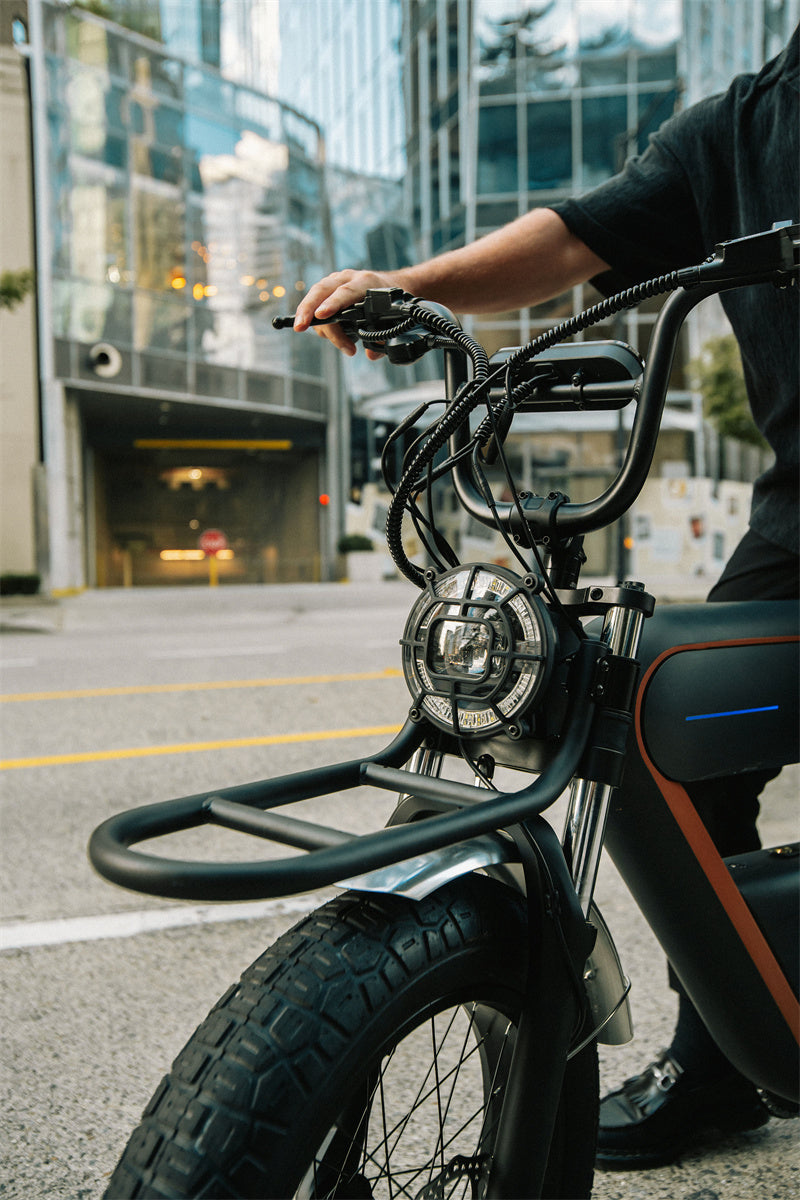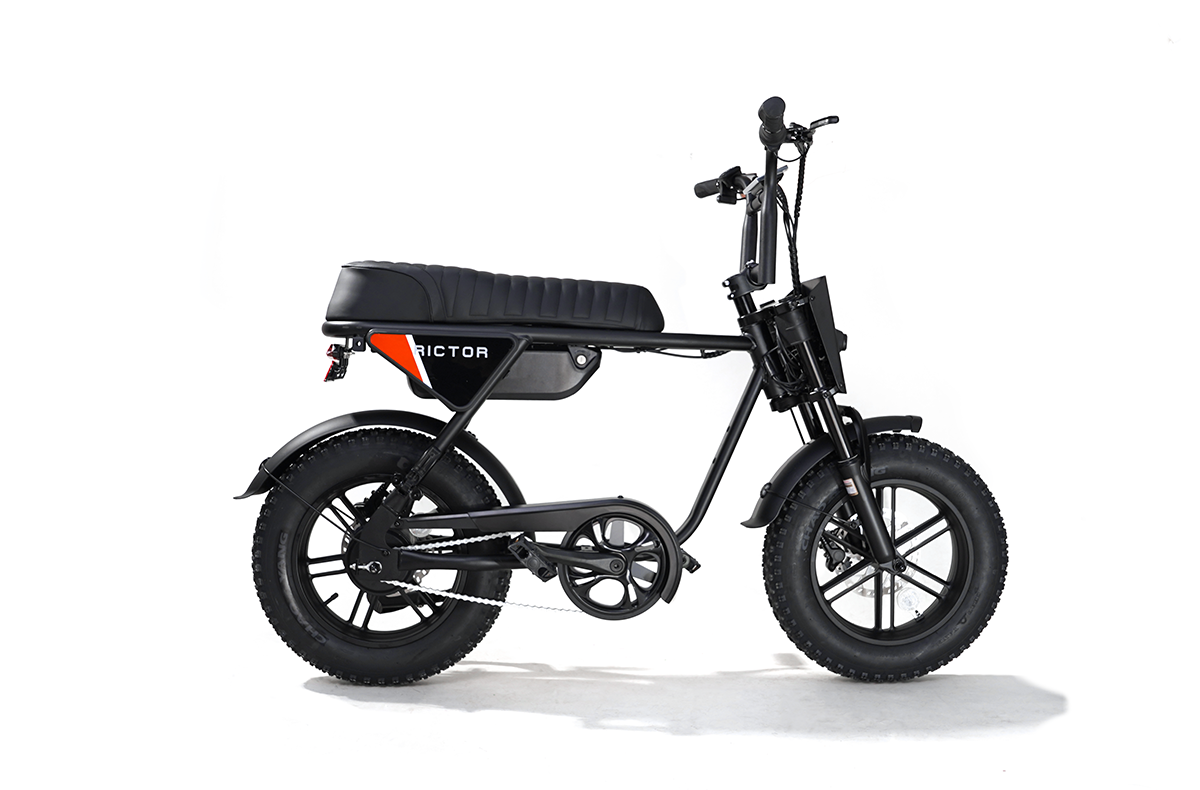
The Top Speeds You Can Hit on an Electric Bike
The Rictor K1 is an electric bike equipped with a powerful 750W motor and a 48V battery, offering impressive performance in two different modes.
In Electric Mode, the bike can reach a top speed of 20 mph, while Pedal Assist Mode pushes that speed up to 28 mph. But is 28 mph really the limit for an e-bike?
Or can it go even faster under the right conditions?
Let's dive into what influences electric bike's speed and explore whether 28 mph is just the beginning.
Speed: It’s Not Just About the Motor
While the motor plays a significant role in determining an electric bike's speed, it’s not the only factor at play.
The wattage of the motor is one of the most critical aspects influencing speed, especially when riding uphill or carrying heavy loads.
A motor’s wattage is like its horsepower.
750W motor provides a substantial boost, helping you accelerate from a standstill to 20 mph faster than a 250W motor would in similar conditions.
That said, the motor isn't doing all the work — speed is a combination of factors working together, and the motor is just one piece of the puzzle.
Even with a higher-wattage motor, other elements, like terrain, weight, and riding habits, will influence how fast you can go. You also have to account for how the motor interacts with these factors.
While a 750W motor can handle inclines more easily, it might also drain the battery faster when consistently riding at top speeds.
Below is a simple guide to show how different wattage levels correlate with speed potential.
|
Motor Wattage |
Top Speed (mph) |
|---|---|
|
250W |
15-20 mph |
|
500W |
20-25 mph |
|
750W |
25-28 mph |
|
1000W |
28-35 mph |
|
2000W |
35-45 mph |
|
5000W |
50+ mph |
Weight: Both Yours and the Bike’s
Weight plays a major role in determining the overall performance of an electric bike, especially when it comes to speed and acceleration.
The weight of the bike and the rider significantly affects how quickly the bike can get up to its top speed.
Think about it this way: riding a lightweight bike with a light rider will allow the motor to reach top speeds more quickly compared to a heavier bike or rider.
A lighter rider on a lightweight bike will naturally allow the motor to reach higher speeds more quickly compared to a heavier rider or bike.
A 250W motor can push a 50kg rider to around 20 mph fairly easily.
However, for a rider weighing 100kg, the same motor would struggle to maintain the same speed, often capping at around 15 mph due to the extra load.
Here’s an example of how weight can influence speed:
|
Rider Weight |
Motor Wattage |
Top Speed (mph) |
|---|---|---|
|
50kg |
250W |
20 mph |
|
75kg |
250W |
18 mph |
|
100kg |
250W |
15 mph |
|
100kg |
500W |
20 mph |
|
100kg |
750W |
25 mph |
SEE ALSO NEW Law is Coming! Do you need a license for electric bike?
Terrain: The Road’s Got a Say, Too
Terrain is a key factor that determines how fast an electric bike can go.
A flat, smooth surface allows the bike to reach higher speeds with minimal effort, enabling the motor to maintain a consistent pace.
On rougher or uneven surfaces, like gravel or dirt, the motor must work harder to overcome friction and resistance, which can lead to a significant reduction in speed.
On smooth pavement, an e-bike with a 500W motor might comfortably maintain a speed of 20 mph.
However, the same bike could slow to 12-15 mph on a gravel path due to the increased resistance.
Uphill climbs present an even greater challenge, as gravity pulls the bike downward, forcing the motor to expend more energy to maintain speed.
On a steep incline, that same 500W motor may only manage 8-10 mph, depending on the grade of the hill.
Conversely, when riding downhill, gravity assists the motor, allowing the bike to reach much higher speeds with less effort, sometimes exceeding 25 mph depending on the slope.
|
Terrain Type |
Motor Wattage |
Top Speed (mph) |
|---|---|---|
|
Smooth Pavement |
500W |
20 mph |
|
Smooth Pavement |
750W |
25 mph |
|
Smooth Pavement |
1000W |
30 mph |
|
Gravel Path |
500W |
12-15 mph |
|
Gravel Path |
750W |
15-18 mph |
|
Gravel Path |
1000W |
20 mph |
|
Steep Incline |
500W |
8-10 mph |
|
Steep Incline |
750W |
12 mph |
|
Steep Incline |
1000W |
15 mph |
|
Downhill Slope |
500W |
25+ mph |
|
Downhill Slope |
750W |
30+ mph |
|
Downhill Slope |
1000W |
35+ mph |
The Law: Speed Limits Apply
When it comes to electric bike speed, it's not just about what the bike can do — local laws play a significant role in regulating how fast you’re allowed to go. In the United States, there are three main classifications for e-bikes, each with its own speed limit.
Class 1 e-bikes provide pedal-assist up to 20 mph, making them ideal for riders who want some assistance without relying on a throttle.
Class 2 bikes include both pedal-assist and throttle modes, but they are still capped at 20 mph.
Class 3 bikes, however, offer pedal-assist up to 28 mph, making them the fastest e-bikes legally available for most riders.
Once you hit these legal speed limits, your bike's motor stops providing assistance, meaning you’ll have to rely on your legs for any additional speed.
These classifications are designed to keep riders safe and ensure that e-bikes remain distinct from motorcycles.
Depending on where you live, these laws may vary, so it’s important to check local regulations to ensure you're riding within the legal speed limits for your area.
Core Exercises for E-Bikes? Sort Of.
Managing your bike’s speed isn’t just about how fast you twist the throttle. It’s also about how you manage your battery.
The faster you ride, the quicker your battery drains, creating a trade-off between speed and distance.
Higher speeds require more energy from the motor, meaning your battery will deplete faster than if you were riding at a slower, more moderate pace.
If you’re planning a long ride, it’s important to balance your speed with battery management.
Many electric bikes offer different riding modes, allowing you to switch between power-saving modes and full-throttle modes depending on your needs.
Here are some essential tips to help maintain your e-bike’s battery life:
✅ Avoid full discharge: Try to recharge your battery before it drops below 20%, as fully draining the battery can shorten its lifespan.
✅ Store in a cool, dry place: Extreme temperatures, both hot and cold, can damage the battery. Aim to store it between 50°F (10°C) and 77°F (25°C).
✅ Don’t overcharge: Unplug the battery once it’s fully charged to prevent overcharging, which can degrade the battery over time.
✅ Use eco mode: On longer rides, switch to eco or power-saving mode to reduce power consumption and extend battery life.
✅ Check for software updates: Some e-bike batteries come with smart management systems that require software updates to optimize performance.
By following these tips, you can keep your battery running efficiently and extend the life of your electric bike.
What’s Your Speed Style?
Your preferred riding speed will largely depend on what you’re using the e-bike for.
If you’re using it for commuting, you might prioritize speed to ensure you arrive at your destination on time.
In that case, a Class 3 e-bike with a 28 mph top speed could be the ideal choice.
Bikes like the Rictor K1 are designed to maximize both speed and range, making them perfect for riders who need a reliable, fast commuter bike.
If you’re simply using the bike for leisure or weekend rides, a slower, smoother ride might be more your style.
A Class 1 bike that offers pedal-assist up to 20 mph could provide the perfect balance of speed and comfort.
Ultimately, the best speed for you depends on how you plan to use the bike and what kind of experience you’re looking for.
Whether you're commuting, exercising, or just enjoying a casual ride, there’s a bike designed to match your speed style.
Battery Life vs. Speed: The Final Showdown
As far as electric bikes are concerned, speed and battery life are always in a delicate balance.
The faster you go, the more energy the motor requires, which means your battery will deplete more quickly.
This can cut down on the overall range of your ride. If you’re pushing the bike to its top speeds for long stretches, you’ll notice your battery life dwindling faster than if you kept a steady, moderate pace.
Many electric bicycles come with different riding modes that allow you to control how much power the motor is using.
By switching to a lower-power mode, you can extend the life of your battery and ride for longer distances.
However, riding slower doesn’t necessarily mean sacrificing the fun. Slowing down a bit can also give you more control and a smoother riding experience.
FAQs
Can I modify my e-bike to go faster than 28 mph?
Yes, but modifying your e-bike to exceed legal speed limits may void the warranty and could be illegal in some areas. It’s essential to check local regulations before making any changes.
How do weather conditions affect my e-bike’s speed?
Extreme weather, such as heavy rain or strong winds, can reduce your bike’s speed by adding resistance or making the terrain more difficult to navigate.
Does an e-bike’s speed affect its battery life?
Yes, riding at higher speeds will deplete the battery faster. The more power the motor uses to maintain speed, the shorter the range before a recharge is needed.
💡 Explore More Here!
- The RICTOR K1 is the BEST ALL AROUND EBike Under $2,500!
- Are e-bikes waterproof? the truth might surprise you!we still have owesome recommendation
- Your handy checklist for buying a new e-bike, don't miss your best bike
- How Fast Can E-Bikes with Different Voltages Go?
- Are Electric Bikes Allowed in National Forests? (In Some, Yes)



